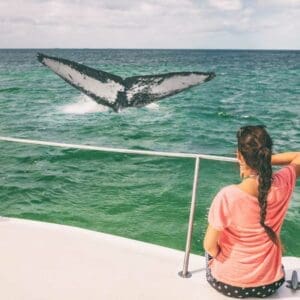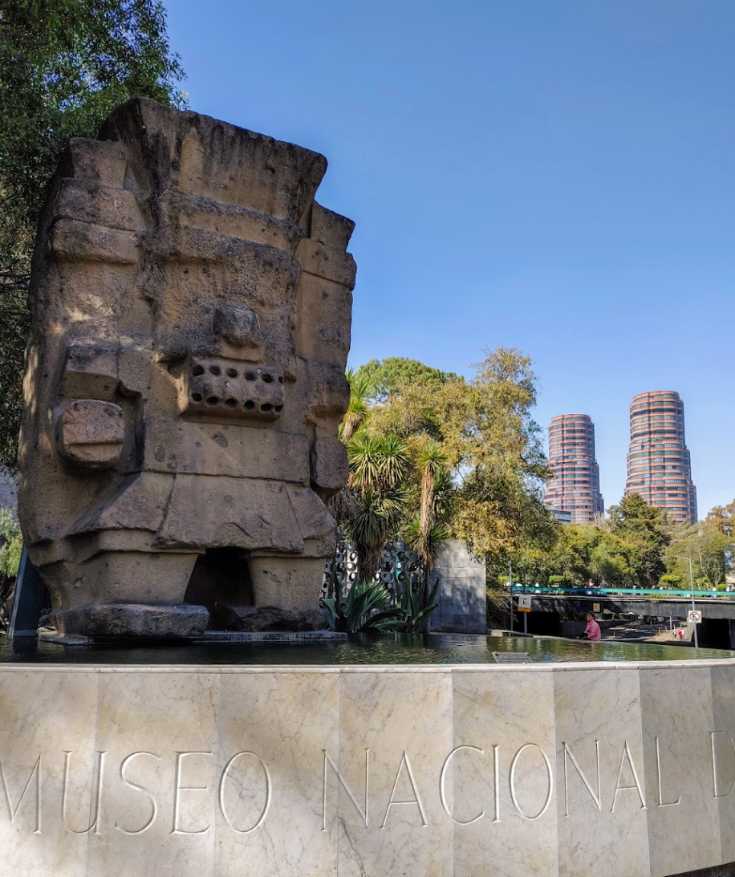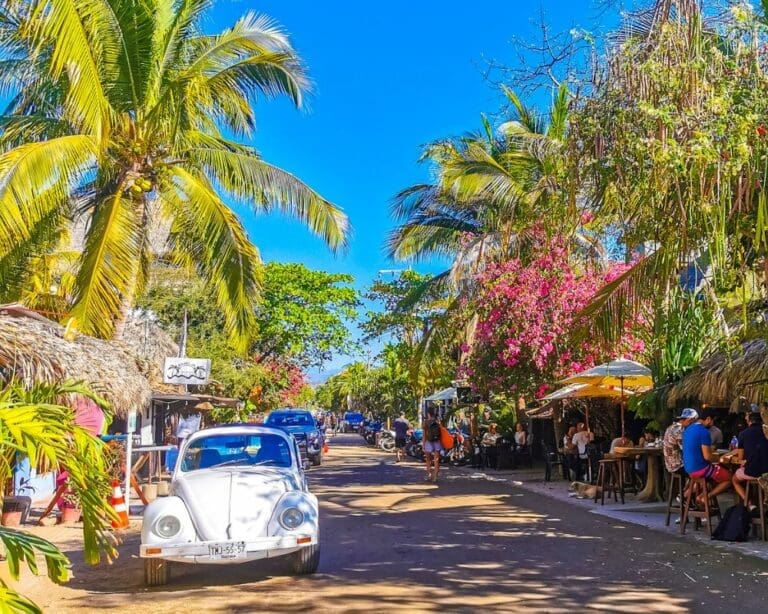From Baja to Yucatán: Mexico’s top whale watching destinations
The season of whale watching in Mexico is here! From living here, I’ve done whale expeditions in Mexico and here’s everything you need to know about seeing these gentle giants.
Mexico is a favored destination for several species of whales due to its diverse marine ecosystems, warm waters, and geographical location along migration routes.
No matter where you go on a vacation in Mexico, as long as it’s season, you will definitely see the whales. However, if you want an up-close experience, there are a few areas where you can see (and touch) them!
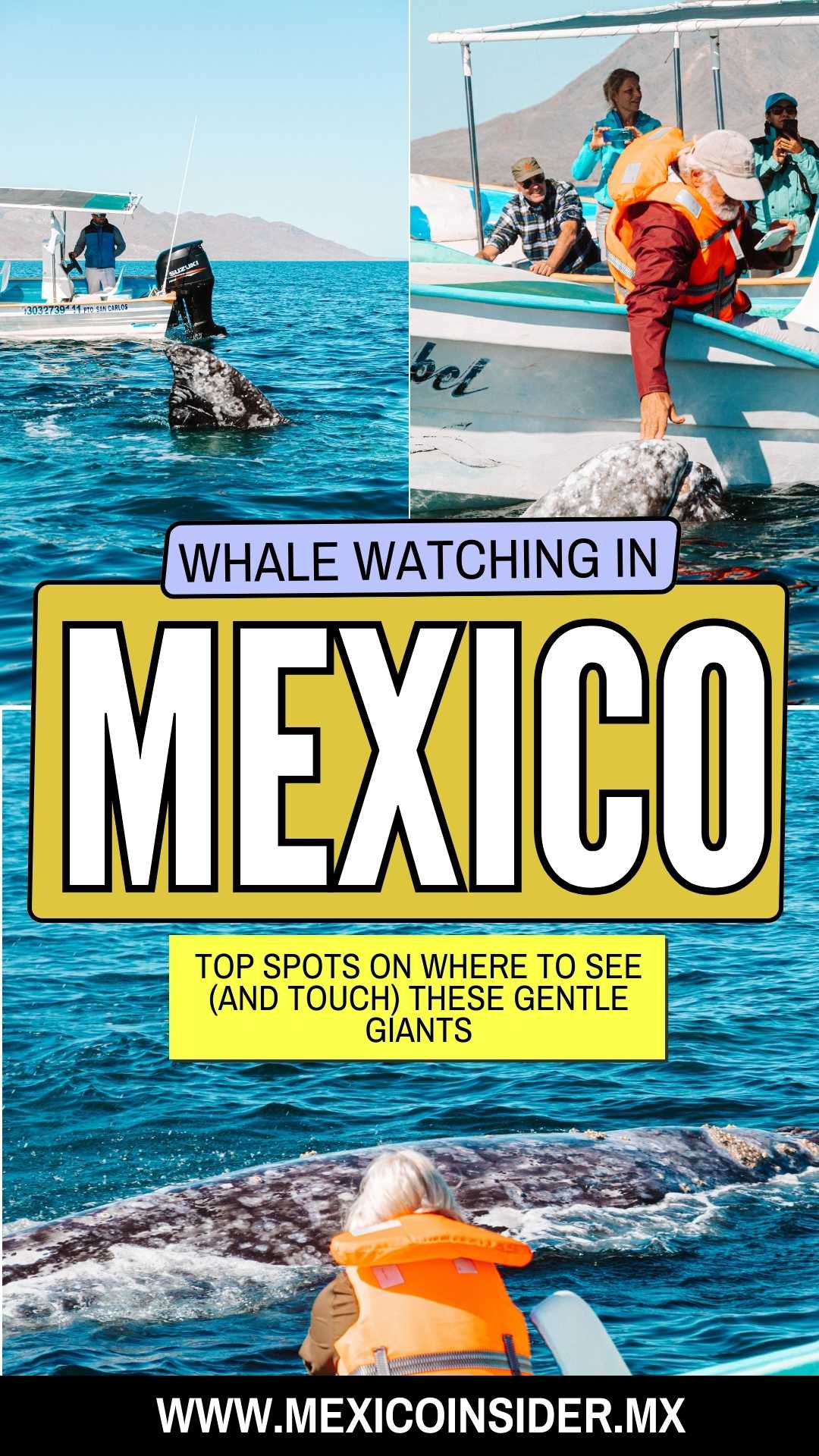
I live in Baja California Sur so I will always be bias to this region as the best whale watching spot in Mexico. But if you don’t plan to visit Baja, there are few other choices!
Here are the top destinations for whale watching in Mexico, from the tranquil lagoons of Baja California and the vibrant waters of Puerto Escondido to the azure bays of the Yucatán Peninsula.
Plan your trip to Mexico with us! Get expert travel advice and customized trip-planning itinerary from our local experts on the ground.
📅 Best months for whale watching in Mexico

The best time to go whale watching in Mexico primarily spans the winter and early spring months, from December to April.
During this Mexico whale watching season, various species of whales, notably the gray and humpback whales, migrate from the colder waters of the Arctic to the warmer lagoons and coastal waters of Mexico for breeding and calving.
The sheltered lagoons and bays, especially in Baja California, become nurseries for these majestic creatures. You can observe intimate behaviors, such as mothers nursing their calves and teaching them essential life skills.
Humpback whales are especially active during this period, engaging in spectacular displays of breaching, tail-slapping, and singing, making for an unforgettable viewing experience.
The winter months also offer pleasant weather, making boat trips and observation more enjoyable and comfortable for visitors.
FYI, whale watching in Baja California will be sunny but cold so bring a jacket or a windbreaker during the boat trips.
🗺️ Mexico whale watching map
Below is the map of the best whale watching in Mexico spots. You can open this in full view on Google Maps.
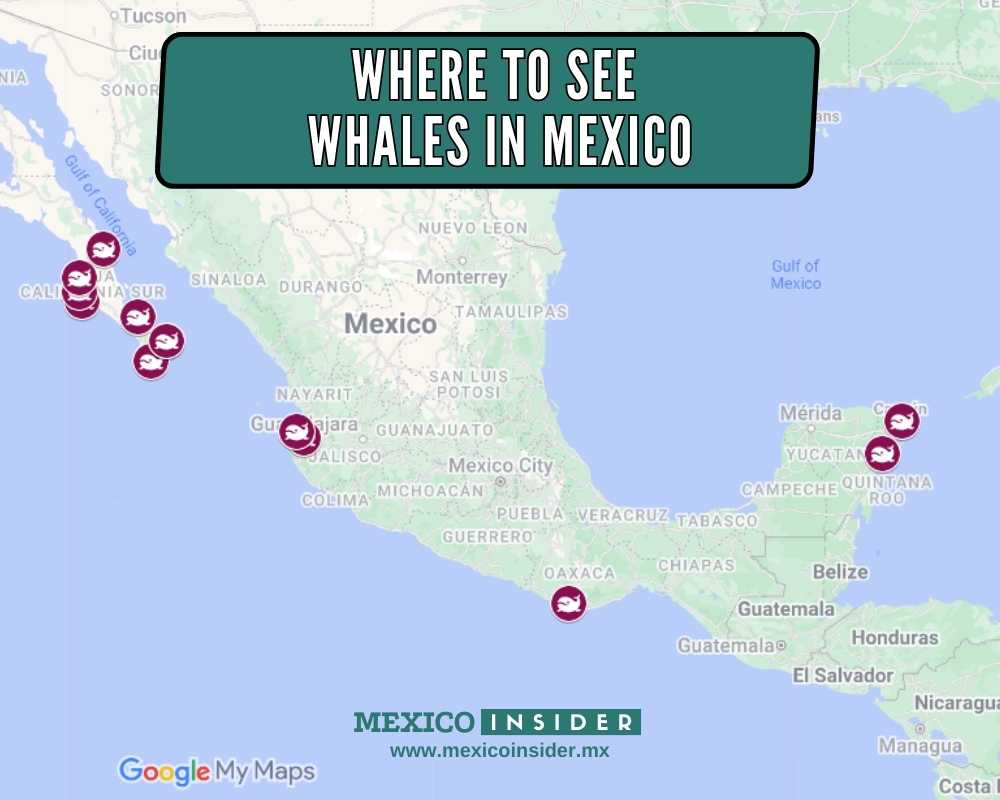
🐋 Top destinations for whale watching in Mexico
Here are some of the primary whale species that visit Mexico and the reasons they are attracted to the region including where to find them:
Best for humpback whales: Cabo
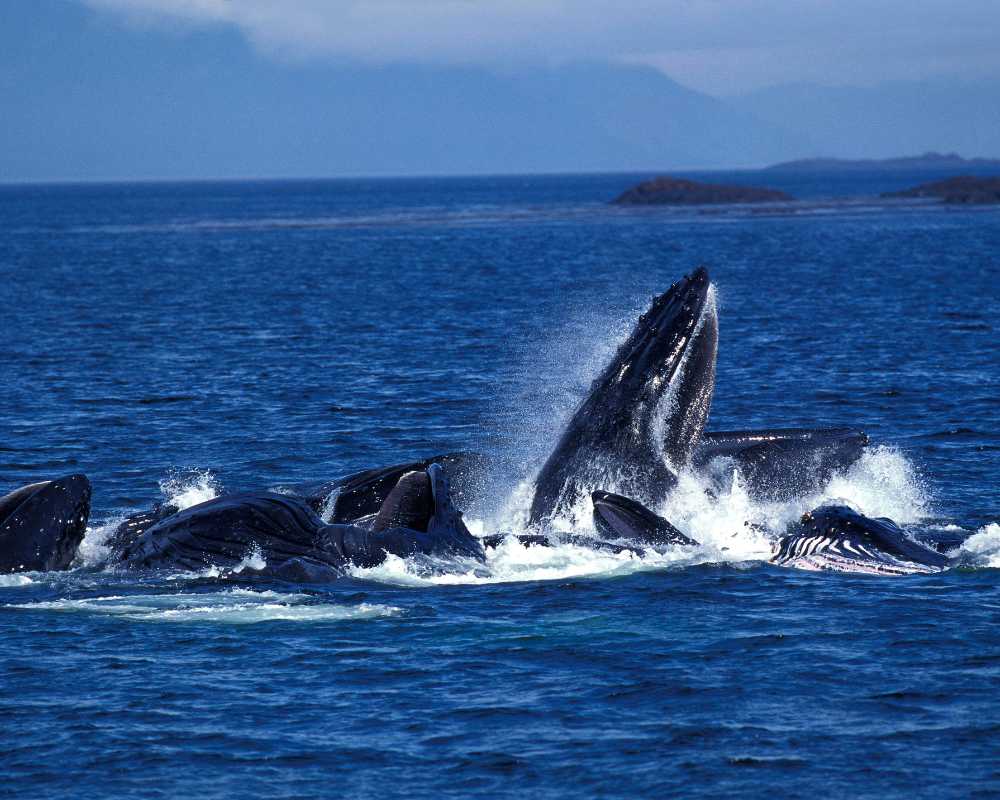
Humpback whales (Megaptera novaeangliae) are one of the larger species of baleen whales, characterized by their long pectoral fins, distinct humped backs, and remarkable acrobatics.
They are renowned for their melodic songs, which can last up to 20 minutes and are a complex sequence of moans, howls, and cries.
Humpbacks are migratory, traveling thousands of miles each year between their feeding and breeding grounds.
Cabo, or more precisely Cabo San Lucas is a frequent destination for humpback whales for several reasons.
The warm, sheltered waters around Cabo provide a suitable environment for humpback whales to mate and give birth. These conditions are safer for young calves, reducing the risk from potential predators.
While humpbacks don’t primarily feed in Cabo, the nearby waters of the Baja Peninsula and the Sea of Cortez offer a rich food supply during their migration.
Humpbacks typically migrate from colder feeding areas like the waters off Alaska to warmer breeding grounds in places like Cabo.
This predictable pattern means that they frequent Cabo’s waters during their annual migration, especially between December and April.
Best for gray whales: Magdalena Bay
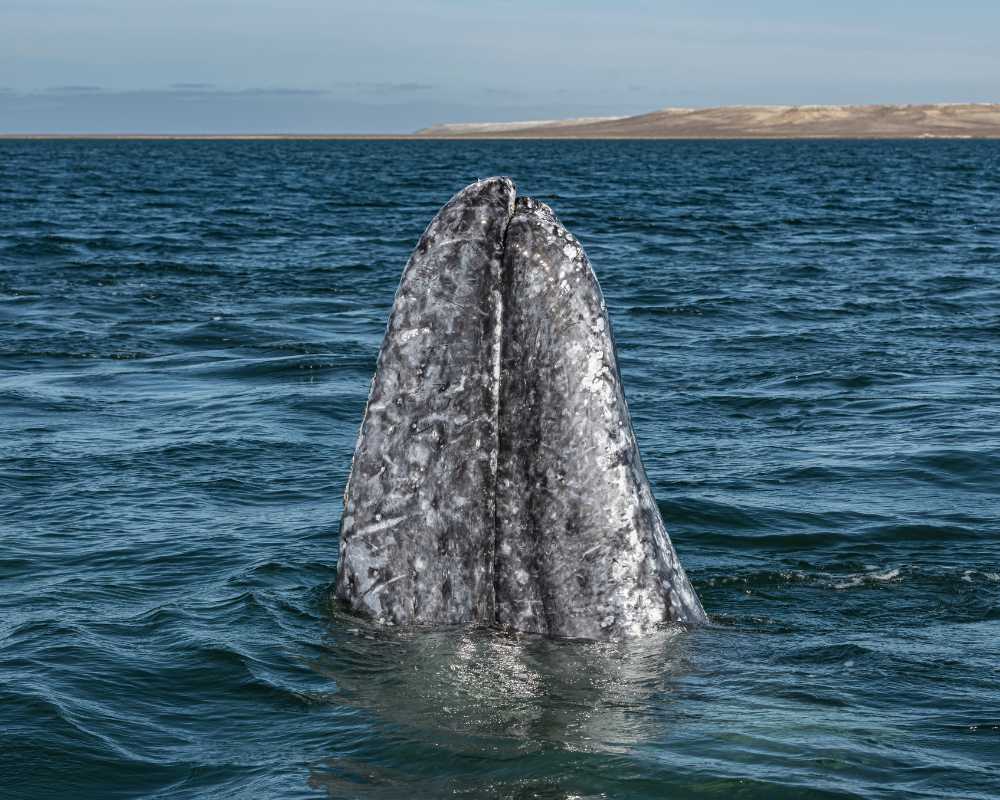
Gray whales (Eschrichtius robustus) are large cetaceans known for their mottled gray appearance, robust body, and the series of knuckles or bumps along their back, leading to the tail flukes.
They have a unique feeding pattern, often scooping up sediment from the seafloor to filter out tiny organisms, leaving mud trails behind them.
The warm, shallow, and sheltered waters of Magdalena Bay provide an ideal sanctuary for gray whales to give birth and nurse their calves. The bay’s protection reduces the risk of predation on the vulnerable young whales.
The lagoons and channels of Magdalena Bay are relatively protected from potential open ocean threats, offering the whales a safer environment to raise their calves during their initial months.
Gray whales embark on one of the longest migrations of any mammal, traveling from their feeding grounds in the Arctic’s cold waters to the warmer breeding grounds along Baja California.
Magdalena Bay is one of the primary destinations on this migration route, with its favorable conditions drawing them back year after year.
Best for blue whales: Loreto
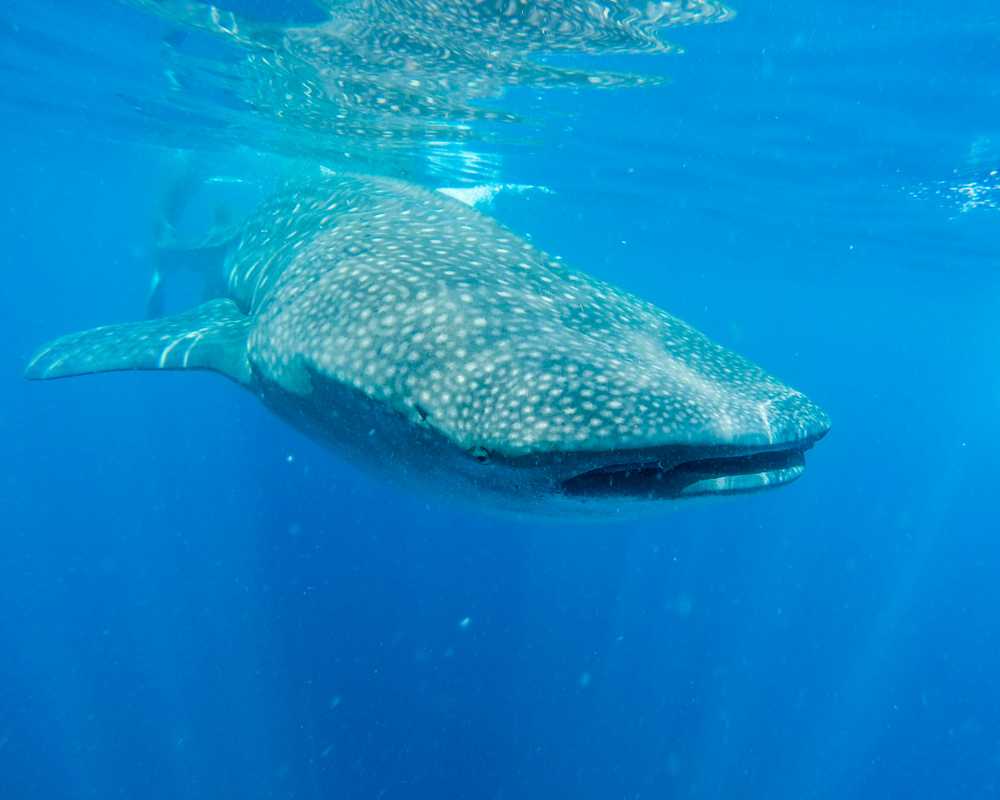
Blue whales (Balaenoptera musculus) are the largest animals ever known to have lived on Earth, reaching lengths of up to 100 feet and weighing as much as 200 tons.
These marine giants are characterized by their mottled bluish-grey skin, slender bodies, and an impressively large mouth, capable of taking in vast amounts of water filled with their primary food source, krill.
The Sea of Cortez, often dubbed the “world’s aquarium” by Jacques Cousteau, is teeming with marine life. The nutrient-rich waters support a large quantity of krill, the primary food for blue whales, making it a feeding hotspot.
The relatively sheltered waters around Loreto provide blue whales with a safer environment away from potential threats and the rougher conditions of the open ocean.
Blue whales undertake long migratory journeys, traveling from polar feeding areas to warmer waters during different seasons. The Sea of Cortez and, by extension, Loreto, is one of the key regions they frequent during their migration.
The convergence of these factors makes Loreto a significant destination for observing blue whales, especially between January and March, when they are most commonly sighted in this region.
Best for whale sharks: Cancun
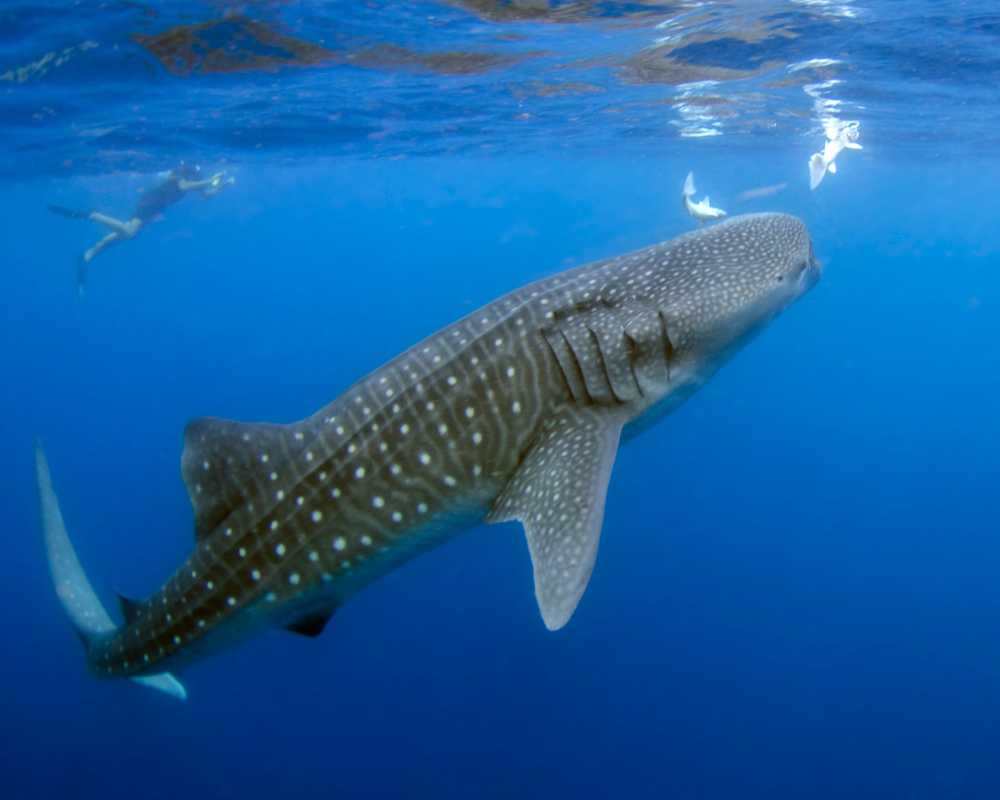
Whale sharks (Rhincodon typus) are the world’s largest fish, with lengths reaching up to 40 feet or more.
Despite their massive size, they are gentle filter-feeders, primarily consuming tiny plankton, small fish, and krill.
They are characterized by their broad, flat heads, distinctive white spots and stripes on a blue-gray background, and wide mouths that can span up to 4 feet.
Between May and September, the plankton-rich waters off the coast of Cancun provide an ample food source for these colossal creatures.
This surge in plankton and small fish attract whale sharks in search of feeding hotspots.
While the primary draw for whale sharks in the Cancun region is feeding, it’s also believed to be a part of their migratory path and might play a role in their mating rituals.
The tropical waters around Cancun offer a suitable environment for whale sharks, ensuring they can efficiently digest their food and maintain optimal body functions.
⛵ Whale watching in Baja California, Mexico
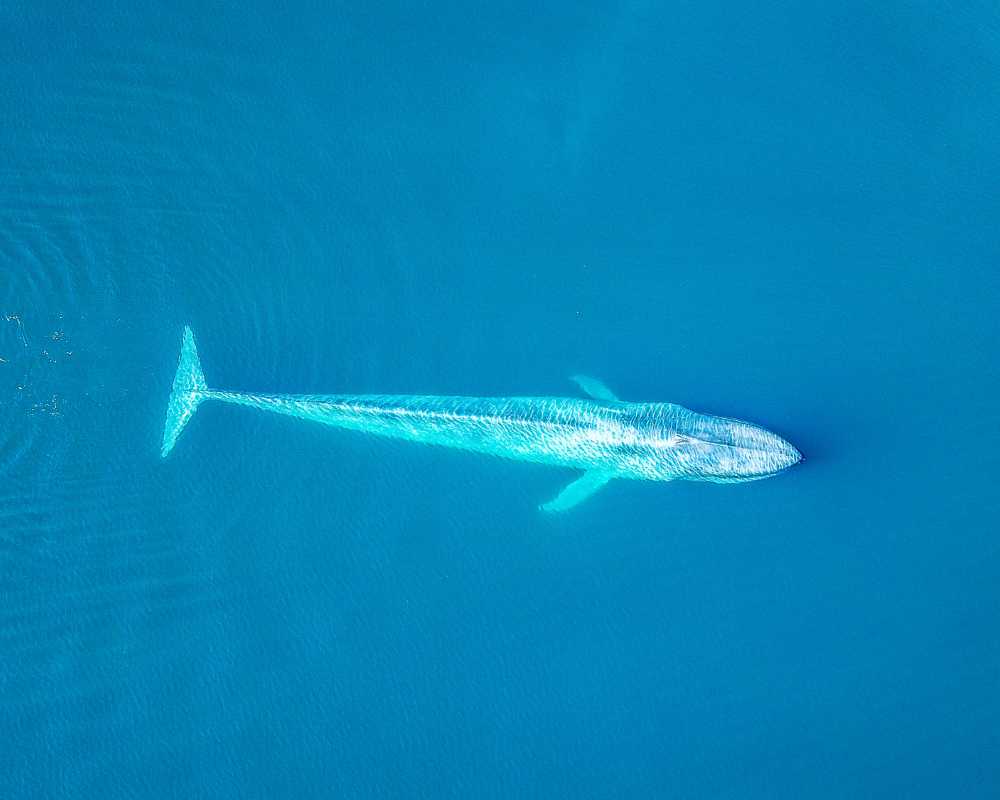
Baja California, a slender peninsula stretching along Mexico’s northwest, is a mesmerizing canvas for one of nature’s grandest marine spectacles: whale migration.
Between December and April, the warm, sheltered lagoons and bays of Baja become nurturing grounds for various whale species, notably the gray whales.
These majestic creatures undertake a monumental journey from the icy Arctic waters to Baja’s tranquil sanctuaries to give birth and raise their calves.
Below are the top spots to go whale watching in Baja California Sur, Mexico:
Magdalena Bay Whale Watching
✈️ Los Cabos or La Paz Airport
📍 Open on Google Maps
🛏️ See all MagBay hotels
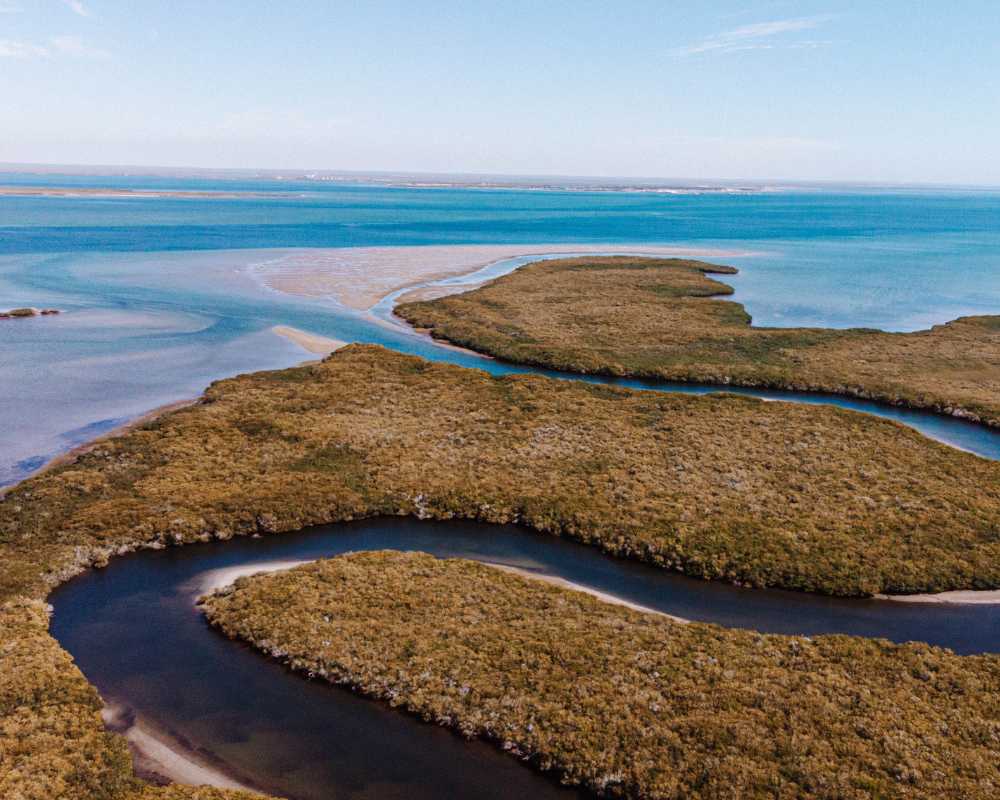
If you are going for the best whale watching in Mexico, choose Magdalena Bay because there is nothing like it. It beats all the Mexico whale watching spots as this is the only place where whales will come to your boat!
The proximity and frequency of these interactions have led to the bay being dubbed a “whale’s paradise.”
Apart from gray whales, the bay occasionally hosts other cetacean species, such as humpbacks and blue whales, making it a veritable treasure trove for marine mammal enthusiasts and a testament to the rich biodiversity of Mexico’s Pacific coastline.
Magdalena Bay, situated along the western coast of Mexico’s Baja California Peninsula, is a renowned haven for whale watching enthusiasts from around the world.
Every year, between late January and early April, the bay becomes a bustling nursery for gray whales who travel thousands of miles from the cold waters of the Arctic to these warm, sheltered lagoons to birth and nurture their calves.
Puerto San Carlos Whale Watching
✈️ Los Cabos or La Paz Airport
📍 Open on Google Maps
🛏️ See all hotels in Puerto San Carlos
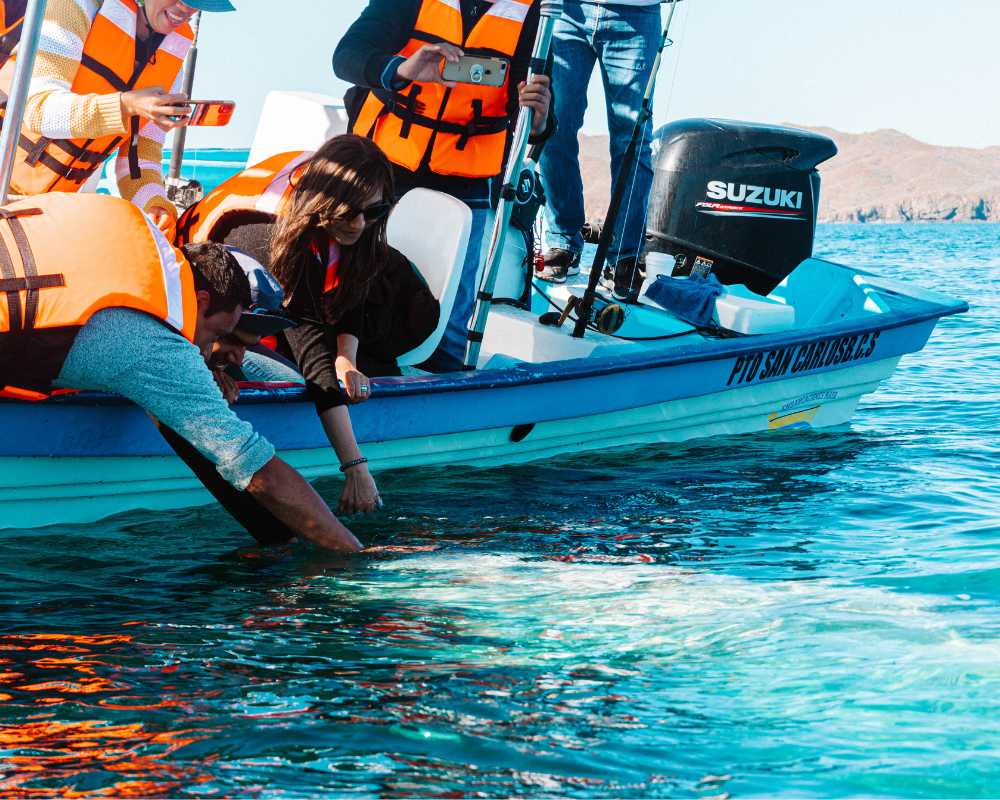
Puerto San Carlos, a serene coastal town in Baja California Sur, Mexico, serves as one of the gateways to the magnificent Magdalena Bay — a celebrated hotspot for whale enthusiasts.
Between the months of January and April, the calm waters of the bay near Puerto San Carlos become a sanctuary for the migratory gray whales.
These majestic creatures travel from the chilly waters of the Arctic to the warm, tranquil lagoons of Magdalena Bay to give birth and nurse their young.
The town becomes a bustling hub during this season, as tourists from around the globe flock to witness the awe-inspiring sight of mother whales and their calves, often breaching or tail-slapping the water’s surface.
Adolfo Lopez Mateos whale watching
✈️ Los Cabos or La Paz Airport
📍 Open on Google Maps
🛏️ See all acccommodations in Lopez Mateos
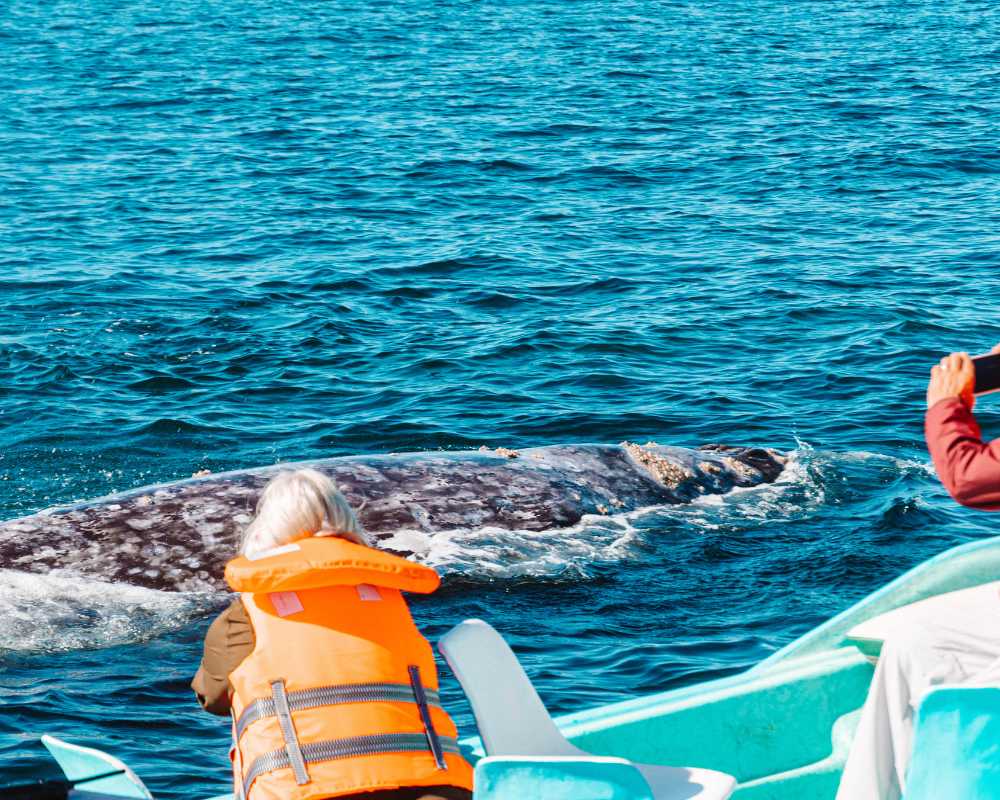
Adolfo López Mateos, a quaint fishing village on the Pacific coast of Baja California Sur, Mexico, is an unsung gem for whale watching aficionados.
Located near the pristine Magdalena Bay, this town becomes a focal point for gray whale observation between January and April each year.
The gray whales embark on an epic journey from the freezing Arctic waters to the warmer lagoons of Magdalena Bay, seeking a safe haven to give birth and nurse their calves.
The sight of playful calves, their protective mothers, and the occasional synchronized breaching is both humbling and exhilarating.
Cabo Pulmo whale watching
✈️ Los Cabos or La Paz Airport
📍 Open on Google Maps
🛏️ See best hotels in Cabo Pulmo

Cabo Pulmo, nestled on the eastern coast of Baja California Sur, is a marine sanctuary acclaimed for its rich coral reefs and marine biodiversity.
Beyond its colorful reefs, between December and March, Cabo Pulmo transforms into a marine theater showcasing the annual migration of humpback and gray whales.
These majestic creatures traverse vast oceanic distances, seeking the warmer waters of the Sea of Cortez for breeding and calving. The protected marine park, with its serene environment, offers an idyllic setting for these whales to nurture their young and engage in intricate courtship dances.
Observers are often treated to breathtaking displays of breaches, fluke slaps, and harmonious whale songs that reverberate through the crystalline waters.
Loreto Whale Watching
✈️ Loreto International Airport
📍 Open on Google Maps
🛏️ See best hotels in Loreto

Nestled on the eastern coast along the tranquil Sea of Cortez, Loreto offers a pristine marine setting.
From December to March, blue whales, the largest animals on Earth, take center stage in these waters, their massive forms dwarfing even the boats from which enthusiasts watch them.
Loreto’s marine park, a UNESCO World Heritage Site, adds an extra layer of protection, ensuring a sustainable and enriching experience for all visitors.
La Paz whale watching
✈️ La Paz Airport
📍 Open on Google Maps
🛏️ See best hotels in La Paz
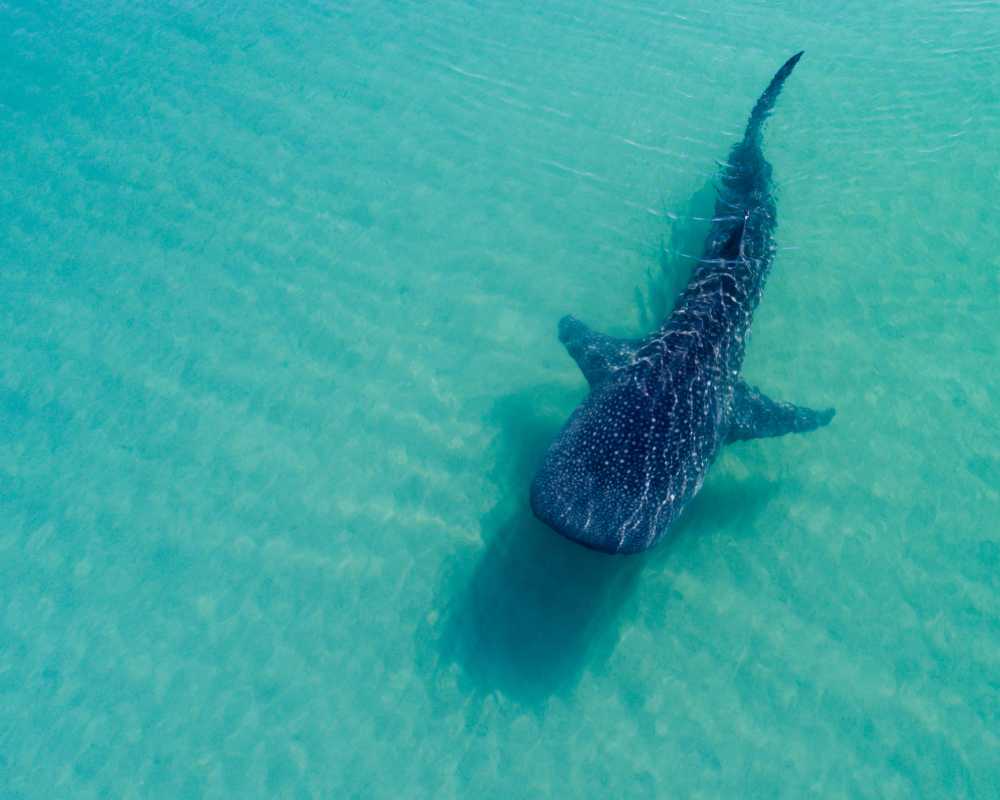
This peaceful bay city has a unique charm that extends beyond its sandy shores. Between December and April, La Paz’s waters become a playground for gray whales, who dance gracefully near the coast.
Moreover, it’s one of the few places on Earth where one can swim alongside whale sharks in their natural habitat, making it a dual attraction for marine aficionados.
Yes, you can swim with whale sharks in La Paz (tours from $129 USD).
Cabo San Lucas whale watching
✈️ Los Cabos Airport
📍 Open on Google Maps
🛏️ See best hotels in Cabo
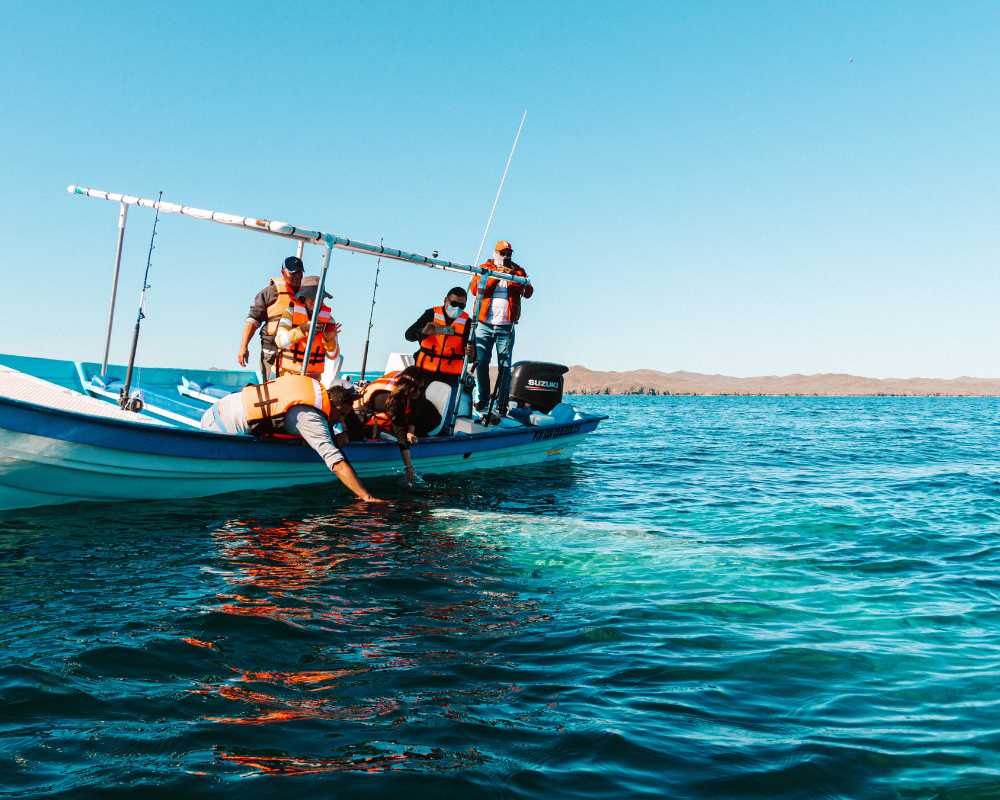
At the southernmost tip of the peninsula, where the Sea of Cortez greets the Pacific Ocean, Cabo San Lucas boasts dramatic seascapes.
From December to April, the bay resonates with the songs of humpback whales.
Their awe-inspiring breaches and tail slaps, paired with the stunning backdrop of the famous Arch, make this destination a photographic dream for nature lovers.
🛥️ Whale watching on the Pacific Coast of Mexico
The Pacific Coast of Mexico is a dazzling backdrop for the annual ballet of whale migration. Between December and April, these majestic marine mammals journey from the chilly Arctic to the warmer, tranquil waters of the Mexican Pacific in search of breeding and calving grounds.
Notably, the gray and humpback whales steal the show with their acrobatic breaches, tail slaps, and intimate interactions near the coast.
Puerto Vallarta whale watching
✈️ Puerto Vallarta Airport
📍 Open on Google Maps
🛏️ See best hotels in Puerto Vallarta
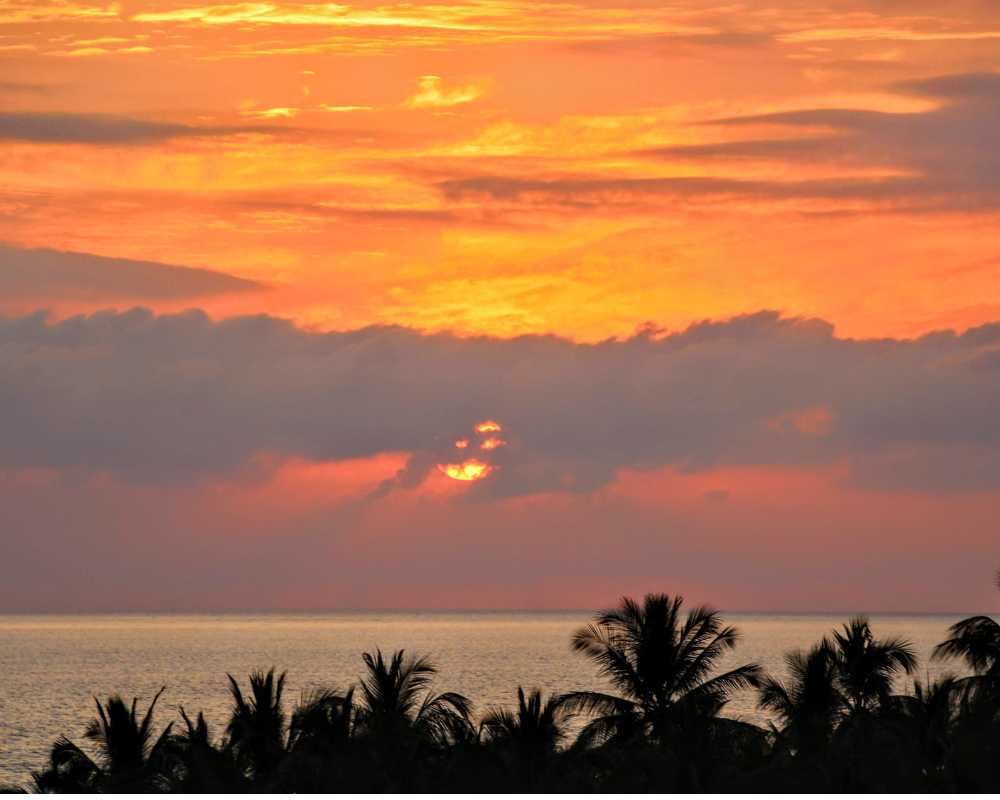
Located on Mexico’s Pacific coastline, Puerto Vallarta stands as a premier destination for marine wildlife enthusiasts.
Between December and March, the bay becomes a theater for humpback whales, who migrate from colder waters to breed and calve in this tropical sanctuary.
Their melodious songs and spectacular aerial displays, often with the backdrop of Vallarta’s scenic coastline, create an unforgettable tableau.
Sayulita whale watching
✈️ Puerto Vallarta Airport
📍 Open on Google Maps
🛏️ See best hotels in Sayulita
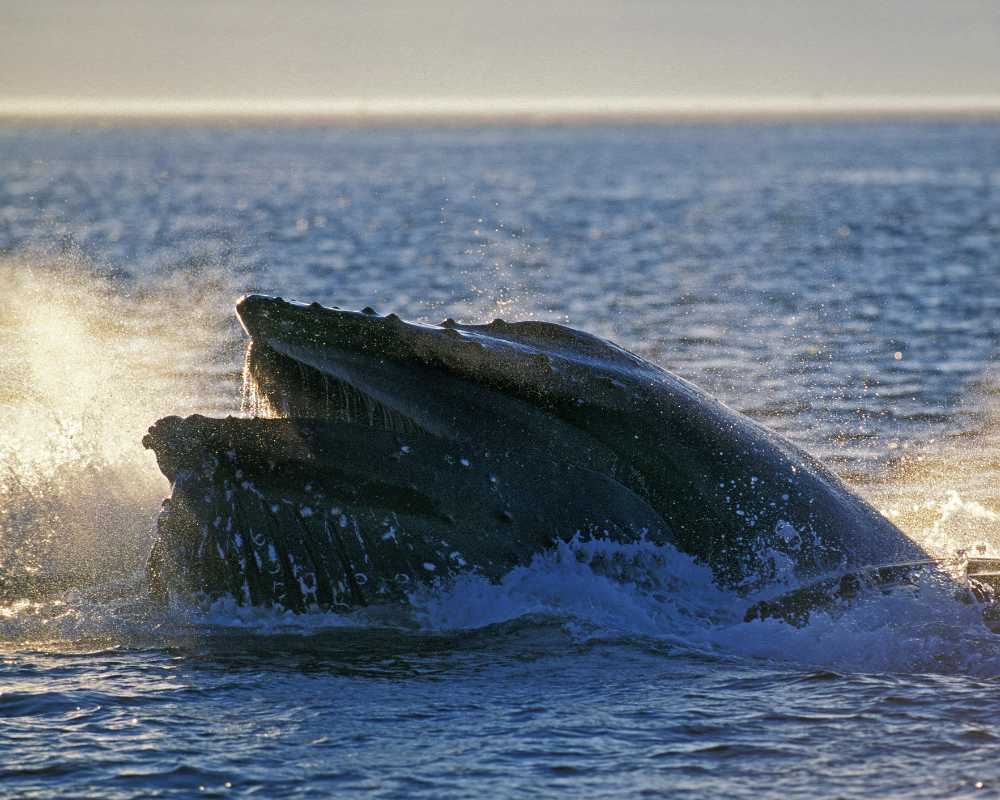
A bohemian gem just north of Puerto Vallarta, Sayulita offers a more laid-back whale-watching experience.
From November to April, the coast near this surf town witnesses the migration of both humpback and gray whales.
The ambiance here is of intimate wonder; smaller tour groups and fewer boats create a serene setting for observing these majestic creatures.
Sayulita’s rustic charm combined with the awe of nature makes it a truly unique spot for whale aficionados.
Puerto Escondido whale watching
✈️ Puerto Escondido International Airport
📍 Open on Google Maps
🛏️ See best hotels in Puerto Escondido

Puerto Escondido, a gem on the Oaxacan coast of Mexico, is not just famed for its surf breaks but also as a window to the wonders of the Pacific marine life.
Between December and April, the waters near this vibrant beach town become a passage for migrating humpback whales.
Drawn to the warmer tropical waters to breed and calve, these majestic creatures can often be seen breaching and splashing their tails, offering a captivating spectacle against the backdrop of the sunset-tinted horizon.
The tranquil bays of Puerto Escondido provide an ideal vantage point for both casual observers on the shore and those venturing out on boat tours.
Adding to the experience, the area’s rich marine biodiversity means visitors might also spot dolphins, turtles, and a myriad of fish species.
🤿 Whale watching on the Caribbean Coast of Mexico
The Caribbean Coast of Mexico, renowned for its azure waters and vibrant coral reefs, offers a distinct whale-watching experience.
Between January and April, the Caribbean waters near the Yucatán Peninsula welcome migrating whale sharks, the world’s largest fish.
Although not technically whales, their sheer size and gentle nature attract enthusiasts to the coastal town of Isla Holbox and the surrounding areas.
Gliding gracefully through the nutrient-rich waters, these gentle giants filter-feed on plankton, often surrounded by a mesmerizing entourage of smaller marine life.
Furthermore, playful dolphins and the occasional humpback whale can be spotted off the coast of Quintana Roo, adding to the region’s marine allure.
Cancun whale watching
✈️ Cancun International Airport
📍 Open on Google Maps
🛏️ See the best resorts in Cancun

Set against the backdrop of the azure Caribbean waters, Cancun is not just a haven for beach lovers but also a hotspot for marine enthusiasts.
Between June and September, Cancun becomes a magnet for the magnificent whale sharks. These gentle filter-feeders converge in the warm waters around Cancun, offering snorkelers a once-in-a-lifetime experience of swimming alongside the world’s largest fish. The sight of these spotted giants gracefully gliding is truly a spectacle to behold.
Tulum whale watching
✈️ Cancun International Airport
📍 Open on Google Maps
🛏️ See the best resorts in Tulum

South of Cancun, the serene beaches of Tulum, renowned for their Mayan ruins and bohemian vibe, also host marine wonders.
During the winter months, especially between January and March, visitors might be lucky to spot pods of dolphins and occasionally migrating humpback whales, adding an extra layer of magic to this mystical destination.
🐳 Sustainability and ethics for whale watching in Mexico

Ensuring sustainability when booking whale watching tours in Mexico is crucial to protecting the marine environment and the magnificent creatures that inhabit it. Here are some sustainability tips to consider:
Choose Certified Operators: Always book with tour operators that have certifications or affiliations with recognized eco-friendly or responsible tourism organizations. This demonstrates their commitment to sustainable practices.
Small Group Tours: Opt for tours that accommodate smaller groups. This reduces noise and disturbance to the whales and offers a more intimate experience.
Maintain a Respectful Distance: Ensure your chosen tour operator follows guidelines regarding safe distances from the whales. Disturbing or getting too close can stress these creatures.
Avoid Chase and Encircle Tactics: Choose operators that adhere to non-invasive approaches, avoiding chasing or encircling whales, which can cause distress.
Educate Yourself: A knowledgeable tourist is a sustainable tourist. Learn about the marine life you’ll encounter and the challenges they face, which can increase your appreciation and drive for conservation.
Minimize Waste: Reduce plastic usage by bringing reusable water bottles, bags, and snacks in eco-friendly containers. Make sure no litter ends up in the ocean.
Avoid Touching: If swimming or snorkeling is part of the tour, like with whale sharks, always avoid touching the animals.
Reduce Carbon Footprint: Consider tours that use sailing boats or more fuel-efficient vessels. Also, compensate for your travel carbon footprint by supporting reforestation or other environmental initiatives.
Support Local Conservation: Often, local communities are involved in conservation efforts. Support these endeavors either directly or by choosing tour operators that give back to these initiatives.
Provide Feedback: After your tour, give feedback to operators about their sustainability practices. Positive reinforcement can encourage even more responsible actions.
By following these tips and prioritizing sustainability, tourists can ensure that they contribute to the protection of the marine environment and its inhabitants, ensuring that future generations can also enjoy the wonders of whale watching in Mexico.


